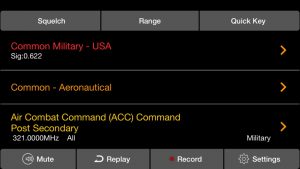Modern scanners have a plethora of various ports, jacks and sockets on them. Here is a look at some of them.

Taking a look at the rear panel of the BCD536HP scanner there are 6 different ports on it. From left to right they are:
- BNC antenna jack
- External Speaker Jack
- USB Port (used for WiFi unit only on the 536)
- GPS Serial Port
- 3-pin power port
- Coaxial power port
Other common ports on scanners include:
- USB programming port
- Record jack
- Headphone jack
- Various serial ports.
Let’s look at each port and what it is used for: (*Bonus! See below for an explanation of the weird hole smack in the middle…)
Antenna Jack: Of course this is used to connect an antenna to the radio. Most scanners these days use BNC, the little push and turn job you see in the picture. Some handled scanners use the smaller SMA connector. Some older scanners had Motorola or even SO139 connectors and some had both an external connector and an internal threaded connector with a hole in the case to insert it.
External Speaker: These are used to plug in an external speaker and are different than headphone jacks. Speaker Jacks do not limit the volume like a headphone jack will. When you plug in a speaker into the external speaker jack the inside speaker is disconnected.
Headphone Jack: The Headphone jack has a limiting circuit to protect from overly loud sound that can damage your hearing. Otherwise it works much like the external speaker jack. Headphone jacks are usually in the front panel of desktop scanners while speaker jacks are usually on the rear. Handheld scanners usually just have a headphone jack on the top.
Record Jack: The Record Jack allows one to pull audio from the scanner at a constant level that is not affected by the volume control. This is important when the radio is used as a source for recording or streaming. Some older RadioShack scanners and some current Uniden scanners have record jacks.
GPS Serial Port: Unique to Uniden scanners, the DB-9 Serial port (male) is used mostly to connect a GPS receiver to allow location based scanning. It can also be used to program or control the scanner with the properly constructed cables. Do not confuse this with the female DB-9 port used for programming on older scanners like the BC780XLT or the BC898T
USB Programming port: Most scanners these days use a USB-Mini port on the front or side to program and control the scanner. On many handheld scanners these ports are also used to charge the batteries and power the radio. On the BCD325P2 a special cable is used to connect a GPS to this port.
Other serial ports: Some older scanners use different type serial ports. Older Unidens (like the “XT” series) use a unique 4-pin square connector for programming and connection of the RH-96 remote head. HP-1 and HP-2 scanners use that same port style for connecting to a GPS. Older design RadioShack/GRE/Whistler scanners use a jack that is just like a headphone jack for serial port connections.
Coaxial Power Port: Most desktop/mobile scanners have a coaxial power port to provide 12 VDC to the scanner. There are 2 different jacks in common use. The majority of Uniden mobile and desktop scanners use a “Type M” male jack while most recent RadioShack, GRE and Whistler mobiles use a “Type T” female jack. Both use center-pin positive. Some older handheld scanners use smaller coaxial power ports but newer portable scanners usually use the USB port for charging and external power.
3-pin power port: This is another unique to Uniden port, similar to the power port used on some of their CB products. On Uniden scanners there are the regular black and red wires for power and a third orange wire used to control the brightness of the display when connected to the lighting circuits of the car.
Discriminator Jack: This is probably the most popular jack that doesn’t come on scanners. Discriminator audio is used to provide an unfiltered audio source mostly for data decoding. This type of decoding usually does not work from the record or speaker jacks due to the filtering circuitry in the radio. Scanners usually do not come with jacks for this but it is often added on by advanced scanner hobbyists to allow data decoding.
Bonus Round
See that threaded hole smack in the middle of the back panel in the picture at the top of the page? Most Uniden base/mobile scanners have that. It is used to allow a rear bracket to stabilize the radio under the dashboard. It is not mentioned in the owner’s manuals but is shown in the diagrams.




